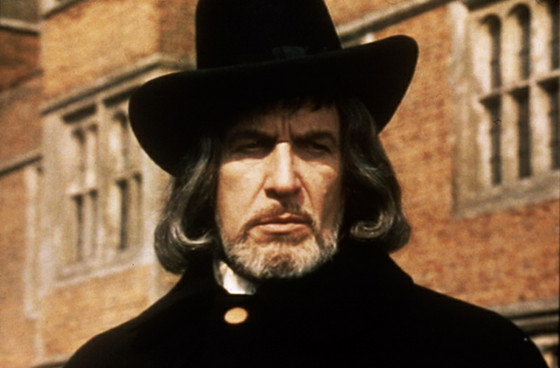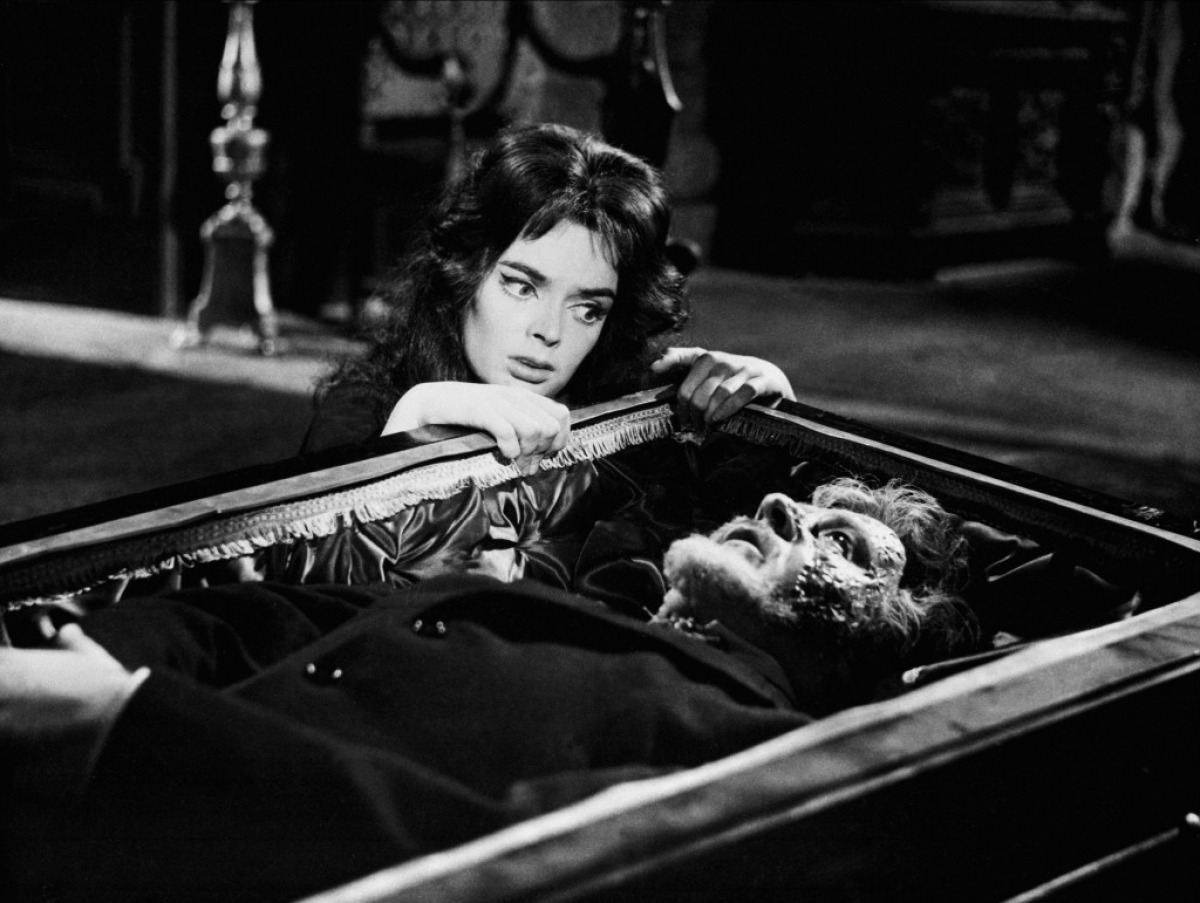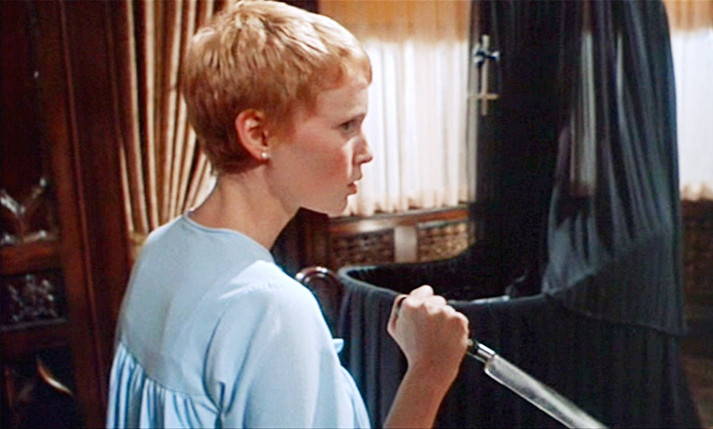8. Blood and Black Lace

A serial killer, wearing a stocking mask and a metal-claw glove, is stalking and murdering models at a fashion salon in Rome.
Mario Bava’s masterpiece is among the earliest and most influential Italian giallo films. The script is acceptable, but the art style is mesmerizing, almost like a painting.
Like Psycho, it helped to create the slasher sub-genre. But Blood and Black Lace is likelyy responsible for the body count slasher, where a psychopath ramps up kills until there are hardly any people left alive. Sadly, it has been imitated so many times that it seems formulaic if you’re watching for the first time on the back of Halloween or Friday the 13th.
Still, Blood and Black Lace is among the best giallo films, and only Suspiria surpasses it in terms of the art style.
7. Witchfinder General

In 17th century England, Matthew Hopkins is appointed Witchfinder General by Puritan Loyalists. He travels from town to town with his henchman, interrogating and torturing those accused of witchcraft to get a confession, though he can be bought. His depravity leads him into more trouble than he could have anticipated.
Vincent Price gives a convincing performance as the vile witchfinder, and you can’t help but to root for him to fail. He is, after all, more monstrous than a lot of supernatural entities. And unlike the other human monsters on this list, he commits his atrocities so he can make some cash.
Reviewers hated the movie because of its intense scenes of violence and torture. However, it developed a cult following and now is regarded as one of the best horror movies of all time.
6. Onibaba

In medieval Japan, a mother and her daughter wait for Kichi, their son and husband, by luring samurai and killing them to sell their valuables. They soon learn that Kichi died in battle, and his wife starts sleeping with Hachi, a neighbor who deserted the war.
The mother fails to take Hachi for herself, so she chooses to scare her daughter-in-law into staying with her for good. She kills a samurai in a horrific mask and wears it to scare her daughter-in-law. However, the mask is now stuck to her face.
This visually striking masterpiece from Kaneto Shindo is emotional, sexual, disturbing and chilling. The swampland seems to have a life of its own, making it the perfect place for the horrific incidents that occur. And the two women are amoral but still undergo suffering when Kichi dies, so it’s hard to champion one over the other.
Onibaba, or Devil Woman, is an atmospheric masterpiece, and being in black-and-white simply makes it all the more striking.
5. Black Sunday

Princess Asa is a high priestess of Satan. She is horrifically executed during the 1600s Moldova via her executioner hammering a spiked mask into her face. Just before she dies, she promises vengeance on the family that killed her. Sure enough, she resurrects two centuries later with her undead henchmen to exact her revenge.
Mario Bava’s horror gem is visually astounding, especially for a black and white film. From one set piece to the next, the atmosphere does an incredible job of showing us the most vivid shades of gray.
The movie is a little over-the-top—vampires, undead servants, loads of gore and more—but it’s one of the best horror movies not just of the 60s but of all time.
4. The Innocents

A woman takes a job at a mansion to take care of the wealthy parents’ two children. The children are angels at first, but they soon display evil impulses. She learns from the housekeeper that they might be possessed by evil spirits; or is she just imagining it?
Based on Henry James’ “The Turn of the Screw”, The Innocents has one of the best ghost stories in cinema. From the chilling beginning to the frightening middle and the ambiguous ending, the movie never lets up. The atmosphere is claustrophobic, the performances are effective and the soundtrack is sinister. All of these make The Innocents one of the scariest movies of all time.
3. Night of the Living Dead

When corpses rise from the grave to devour humans, a group of people take refuge inside an abandoned house. The level-headed Ben tries his best to keep the group from acting erratically. However, when the zombies surround the house, the inhabitants panic.
Night of the Living Dead is one of the most influential films of all time. It spawned the zombie sub-genre, which has been thriving for decade in all entertainment mediums from TV series to video games.
It also had a black protagonist; something unheard of at the time. And don’t forget the gore. Sure, it’s mild in comparison with the considerably gorier sequels, but when it came out, it set new levels of gruesomeness, even being called an “orgy of sadism”.
George Romero went on to make lots of sequels—including the arguably better Dawn of the Dead—but Night of the Living Dead will always be the one that introduced shambling, undead cannibals.
2. Psycho

Marion Crane is on the run with her boyfriend after stealing $40,000 from her boss. They travel on back roads to avoid the police, and stop for the night at Bates Motel. There, they meet Norman Bates, a polite young man with a love for taxidermy. What follows is the opposite of what you might expect, with the main plot twist coming in at almost a third of the film.
Psycho was more than just a good movie; it helped to change horror. Even people who don’t like horror know Norman Bates. He was a monster you could actually sympathize with. The film’s shower murder is one of the most famous scenes in the history of cinema, and it helped to push the boundaries of on-screen violence.
Alfred Hitchcock wanted this movie to resemble a cheap exploitation feature, and he made it in black and white with his TV crew instead of his expensive feature film crew. The result is a horror masterpiece that inspired dozens of others and still remains unnerving to this day.
1. Rosemary’s Baby

Rosemary and her husband Guy move into a New York City apartment where everyone but them is old and their immediate neighbors, Roman and Minnie Castevet, are incredibly nosy.
After his initial discomfort with them, Guy starts spending a lot of time with the Castevets. Rosemary gets pregnant after having a frightening dream in which a beast rapes her. After that, she starts to suspect her neighbors of being more than they appear. But she being delusional or is there really something sinister about their chummy old neighbors?
The film takes its time to ramp up tension, and after Rosemary gets pregnant, you can hardly look away. The performances are mesmerizing, especially from Ruth Gordon as the pushy neighbor, and the morbid fear Rosemary harbors for her unborn child makes the movie incredibly disturbing.
Rosemary’s Baby is Roman Polanski at his best, ramping up the tension while showing plenty of restraint.
Author Bio: Fredrick is a copywriter-cum-scriptwriter with a passion for the macabre. When he’s not watching movies, he’s reading Lovecraftian novels and devouring manga.